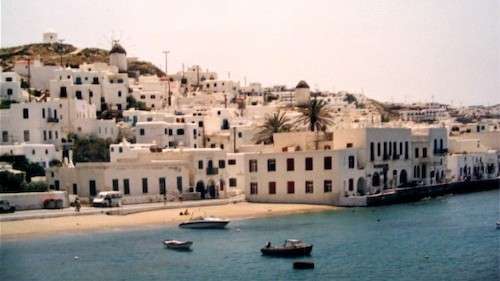One of the most cosmopolitan islands in Greece, Mykonos is popular with gay tourists, known for its intense nightlife and sandy beaches.
One of the top international tourist destinations, famous around the globe for its cosmopolitan character and its intense nightlife. It is also one of the most expensive places, due to the number of gay tourists. Mykonos nightlife focuses mainly on bars rather than clubs, Mykonos is a gay-friendly resort area, featuring several gay bars and clubs open during the summer.
It is believed that the island was named after a local hero, who is considered an offspring of the god Apollo and was worshipped locally in antiquity. In Greek mythology, Mykonos was the location of the battle between Zeus and the Titan, and the island was named in honour of Apollo’s grandson Mykonos.
From as early as the 16th century the Mykonos windmills are one of the most recognized landmarks. Little Venice area where buildings have been constructed right on the sea’s edge with their balconies overhanging the water, and a great place to watch sunsets while enjoying dinner.
Chora, the island’s port town and capital, is a Cycladic town with a maze of tiny streets and whitewashed steps lanes, houses and churches, gathered around its harbour in the middle of a wide bay. Despite the island’s rapid growth and development, it’s traditional Cycladic architectural style and character has remained firmly intact, thanks to the island’s strict building regulations.
Petros the Pelican, the island’s mascot, can sometimes be found at the waterfront or even up in town. Originally the pelican was found wounded off the coast of Paranga shore after a storm back in the 1950s by a local fisherman. The pelican was nursed to health and remained on the island supported by locals. It soon adopted the name “Petros”. To great disappointment by locals and tourists alike, Petros was hit by a car on 2 December 1985 and failed to recover. After Petros died in 1986 he was so popular that a new pelican was introduced as a successor. Now there are three pelicans inhabiting the island.
Most of the beaches have tavernas and restaurants and are well equipped with deck chairs and parasols. The best beaches are on the south side of the island and sheltered from the northern wind. Paradise, the most popular beach on the island, has camping, self-service restaurant, cafeteria, snack bars, beach bars, mini shops and discos. Nudity is quite common.
Paradise Beach is known for its parties, easily reached by bus from Mykonos Town or with a regular boat service. Super Paradise on the south has restaurants, beach bars and some hotels, also very popular with gays, especially the right part. Nudity is quite common.
There is no bus service to Super Paradise, but it is easily accessible with a regular boat service. With your own transport, it is a difficult winding road, 7km from Mykonos Town.
Elia is one of the larger beaches on Mykonos, a well-organized beach with sunbeds and umbrellas, and various water sports, restaurants and taverns, also popular with gays. Nudity is permitted but not as common, concentrated at the right and nicest part of the beach. Elia is most easily reached by a direct local bus from Mykonos Town’s northern bus terminal, but also with a regular boat service from Platys Gialos beach.
I stayed on Paradise Beach Resort, sleeping on the ground with my sleeping bag and less than 100 meters to the beach (at the time I paid $2 per night to stay here(1993)) and only a short ride into the town centre. Self-contained camping with a self-service restaurant, snack bar, beach bar, mini market, boutique and bike rental. A good choice if you want more developed camping and are looking to meet other young backpackers and party all night long.
